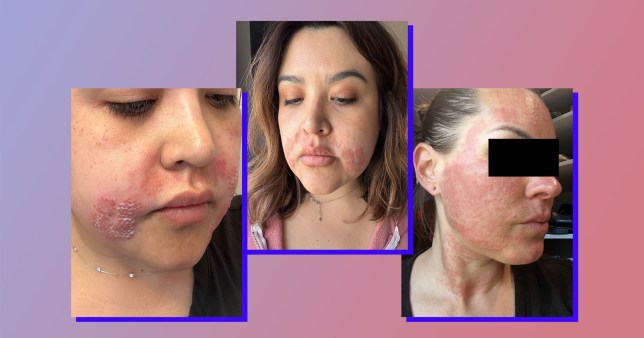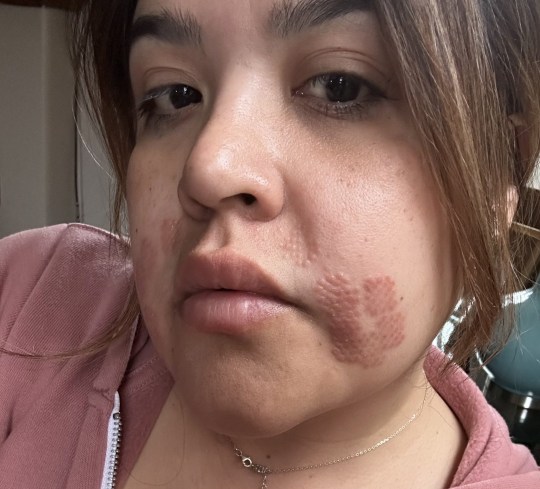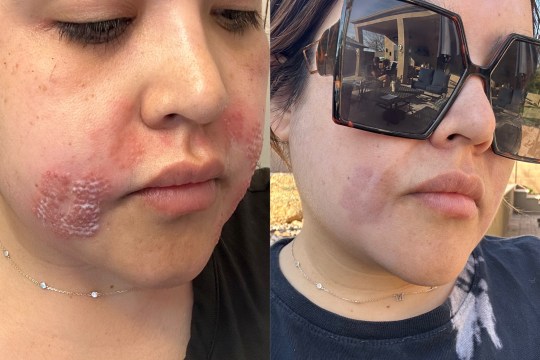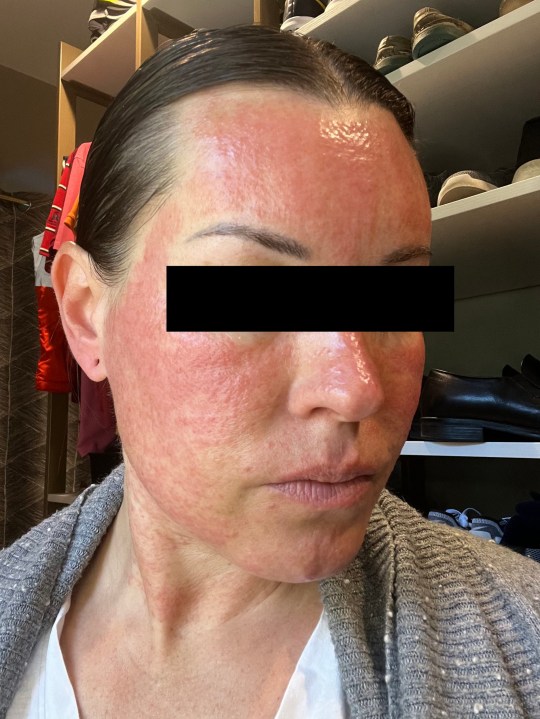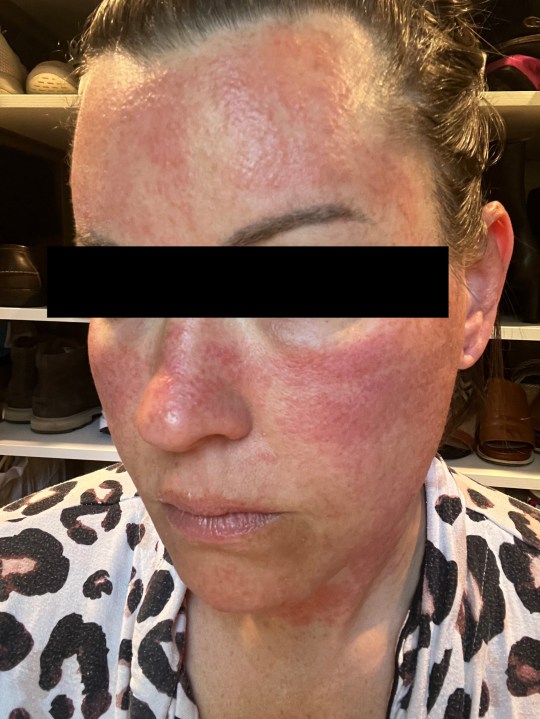‘Within six hours I had severe swelling, gridmarks and blisters stamped all over my nasolabial fold,’ Michelle Wight, 39, tells Metro.co.uk.
The makeup artist, based in Seattle, Washington, USA, went for a Morpheus8 treatment in March 2023, specifically choosing a medical spa she had ‘known and trusted for two years prior’.
But what she thought would be a simple, risk-free procedure ended up in ‘extreme pain’, and Michelle was left feeling ‘deformed’ for months afterwards.
Morpheus8, which combines microneedling with radiofrequency to stimulate collagen production and tighten the skin, is offered by over 200 practitioners throughout the UK and thousands more in the US and beyond.
It’s the best-known among a handful of similar machines using similar technology, each with ‘a difference in how many needles a particular handpiece may have, how deep those needles can go, how adjustable those needles are, even how thick those needles are,’ says to Dr Tapan Patel, medical director of PHI Clinic.
Celebrity fans include Victoria Beckham and Kim Kardashian, with the latter hailing Morpheus8 specifically as a ‘game-changer’ for her beauty routine.
Despite being billed by manufacturers as ‘safe and effective’, though, some recent accounts leave this open to question.
Made In Chelsea star Melissa Tattam said she was left with ‘scarring all over [her] face’ after undergoing the treatment (priced from around £500 per session) in 2023, while one Facebook group dedicated to raising concerns about the potential side effects of Morpheus8 has attracted thousands of members.
Jessica Brown*, 39, is among those unhappy with her experience, telling Metro.co.uk: ‘I was told that inflammation means better results, and I wish I could say ultimately it was worth it, but in my case, absolutely not.’
The stay-at-home mum, from Westchester County, New York, was recommended Morpheus8 during a general skincare consultation with a reputable aesthetician who charged over $1,500 (£1,162) per session.
‘I was completely unfamiliar with it and was told at most there would be 72 hours of light redness following the procedure,’ she says. ‘I trusted who I considered the experts.’
Jessica rates the pain during the treatment at around a four out of 10, with ‘certain spots maybe hitting a brief seven out of 10.’
Afterwards, everything seemed fine, but when she got in the shower the following evening, that all changed.
She recalls: ‘My skin turned bright red, like the worst sunburn of my life, and the texture felt like the back of an alligator. It itched and burned so badly I was unable to sleep or focus on anything other than the pain.
‘My entire face swelled – my head literally felt heavier.’
Jessica immediately contacted the aesthetician who administered the treatment. As well as giving her money back, they prescribed an oral steroid, a cream steroid, and allergy pills, claiming she was experiencing a reaction ‘to the gold metal used in the needles.’
Yet two weeks later, her face was still painful and swollen, and it took a full month for the worst of the symptoms to subside.
‘By the fourth week, I could cover the residual redness with make up, though did continue to have texture issues in some areas,’ she says. ‘But even when I was fully healed my skin looked the same as before the service – what a lesson learned!’
Michelle’s skin took over eight months to heal, with her regular dermatologist (who she contacted in an effort to mitigate long-term effects) providing an oral steroid, topical steroid, SPF and hydroquinone.
Although the spa where she initially had the treatment told her the reaction was caused by an allergy to lidocaine, she says a full panel with her primary care physician revealed she was ‘not allergic to anything.’
According to dermatologist Dr Hassan Galadari, complications following Morpheus8 are rare, but can be as a result of how it’s administered – and who by.
‘Problems can arise from excessive heat generated by the radiofrequency energy, which can damage the skin if not properly controlled,’ he tells Metro.co.uk.
‘Additionally, improper technique or use of the device by inexperienced practitioners can lead to uneven energy distribution, causing burns or scarring.’
Potential side effects
When it comes to radiofrequency microneedling, the most common side effects are pain, redness, purpura (burst blood vessels), and swelling, which resolve on average within five days. Though less common, thermal burns and contour deformities may also occur.
In one trial, 4.8% of patients experienced swelling for six weeks or more and 3.2% had hardened areas of skin for 12 weeks or more as a result of the procedure.
Less than 1% reported rare complications including burns and seromas (an accumulation of serous fluid), while neuropraxia (nerve injury) occurred in 1.2% of patients.
In the UK, there is no specific restriction to who can provide microneedling. Health Education England recommends a Level 6 qualification for tools which penetrate the skin at a depth of 1mm or more, and some local councils require a special treatments license to offer the service.
‘Performed correctly with the genuine device, risks can be managed and mitigated,’ Ashton Collins, director of Save Face, tells Metro.co.uk. ‘However, we have been contacted by patients who have experienced burns and permanent pigmentation or scarring from treatments carried out by non-healthcare providers who may not be using genuine and licensed devices.’
Although the Joint Council for Cosmetic Practitioners (JCCP) hasn’t received complains regarding this, the regulator’s trustee and clinical advisory group chair, Andrew Rankin, says: ‘It does concern the JCCP that any procedure that incorporates a combination of technologies is likely to raise the risk profile, and we encourage members of the public to be aware of these risks, and to seek out the appropriate regulated healthcare professional to perform the procedure.’
InMode, the Israel-based company that developed Morpheus8, offers its own proprietary training for those who offer the treatment, and says it ‘should always be administered by an experienced medical professional.’
But in spite of having US Food and Drug Administration (FDA) approval for Morpheus8, the manufacturer is currently being sued in the state of California for ‘failing to timely report injuries caused by its devices’.
An InMode spokesperson previously commented: ‘The qualifications and skill level of any provider who is administering treatments are of paramount importance, and InMode encourages patients to carry out their own diligence to ensure the device is an authentic Morpheus8 and not an unauthorised counterfeit product.
‘InMode prioritises the safety and efficacy of its products, and takes any patient concerns extremely seriously. Any known adverse effects are reported in accordance with applicable UK (and other) laws; however, InMode can only report adverse effects that it knows about.
‘InMode is proud of its track record of innovation in the medical aesthetics and wellness space.’
RF microneedling aftercare
Dr Patel tells Metro.co.uk: ‘The advice that we give people following a microneedling is dependent on how aggressive we’ve been.
‘If we’ve done a really aggressive treatment, we may just ask the patient to use some very simple skincare and sun protection. However, because these holes that we’ve made through the skin are a really good way of getting active ingredients through, often what we’ll do is give some products like high dose vitamin C or some antioxidants that will then penetrate the skin better following the treatment.’
In general, he recommends a cream with growth factors designed to heal the skin in the days after the procedure, but different clinics will have different products of choice.
Avoiding irritation, infection and sun damage are important for reducing downtime and mitigating the risk of side effects, and some practitioners also warn against hot environments and intense physical activity (which can cause sweating) for 48 hours as a precaution.
If you do decide to go ahead with Morpheus8, it’s vital you weigh up whether you’re suitable for the procedure and choose the right practitioner.
To make sure a provider is reputable, Ashton echoes guidance from the JCCP, warning patients to interrogate discounts and offers.
He says: ‘Genuine Morpheus8 devices are very expensive, which is why treatments with reputable clinics cost upwards of £500 per session.
‘Unfortunately, unscrupulous practitioners can purchase counterfeit devices online for as little as £400.
‘If you see adverts online offering this treatment at low prices, then my advice is to avoid them at all costs, as it indicates that the practitioner is not using a genuine device and significantly increases the risk of potential complications.’
Is RF microneedling right for you?
Providing you’ve done your research and are happy with both the practitioner administering the treatment and the device they’re using, you can usually be considered for radiofrequency microneedling.
‘There are very few people who are unsuitable,’ says Dr Patel. ‘Assuming they’ve got the right indication, which could be crepey skin or acne scarring or just wanting to improve their texture, pretty much everyone could be a suitable candidate.’
However, he adds: ‘Obviously, we apply lidocaine, local anesthetic, so we wouldn’t do it in somebody that was pregnant or breastfeeding.
‘I also wouldn’t do it on anyone who has an active infection. So if they’ve got active cold sores or any other type of skin infection, if they’ve got an active rash, some eczema, psoriasis, again, we would hold off to treatment.’
Ashton also recommends visiting the Save Face website, where you can find a government-approved register of accredited practitioners and clinics who have been assessed and verified to ensure they’re safe.
‘We often say cars don’t cause accidents, drivers do,’ adds Dr Patel. ‘So in the same way when people say, “I got scarred by this machine,” or “I had problems with this machine”, often what I say is, “Well, who is using it?” “How well were they trained?”
‘A lot of risks can be mitigated if the person using the device has a clear understanding of what parameters they should stick to.’
You should always be given a thorough consultation and have your full medical history taken to check if any underlying medical conditions, allergies, or medication may affect your suitability for treatment.
Additionally, Dr Galadari says an assessment can help ‘determine the appropriate settings’ for your individual needs and that, ‘during the procedure, careful monitoring of the skin’s response to the energy is essential.’
Unfortunately however, doing your due diligence doesn’t guarantee you won’t have a reaction like Michelle and Jessica experienced.
Metro.co.uk has contacted InMode for comment on the claims made in this article, and will update with a response when we receive it.
Do you have a story to share?
Get in touch by emailing MetroLifestyleTeam@Metro.co.uk.
MORE : Sienna Miller shares the secret behind her year-long sunkissed look – and it’s under £18
MORE : Shoppers say this top-selling balm is ‘the best natural deodorant’ on the market
Sign up to our guide to what’s on in London, trusted reviews, brilliant offers and competitions. London’s best bits in your inbox
This site is protected by reCAPTCHA and the Google Privacy Policy and Terms of Service apply.

